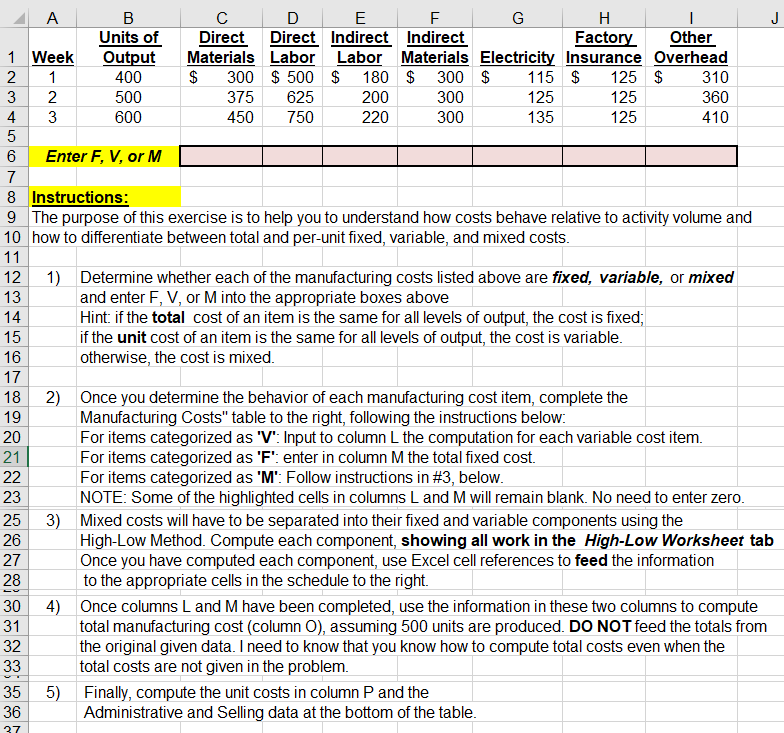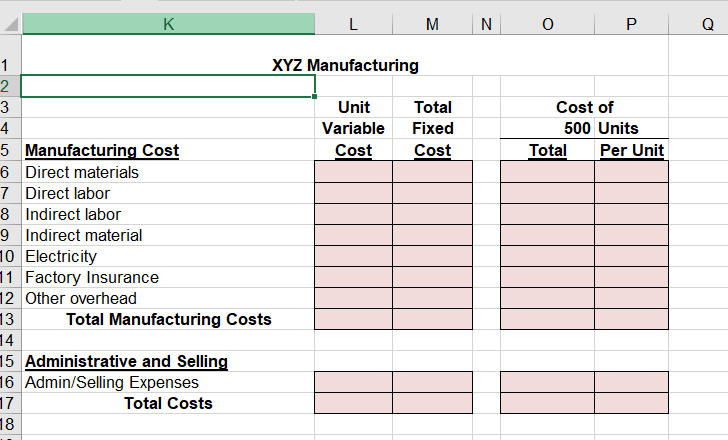Question
XYZ Manufacturing company manufactures a single product. During the past three weeks, the company's cost accountant observed that while input prices were constant, output costs
XYZ Manufacturing company manufactures a single product. During the past three weeks, the company's cost accountant observed that while input prices were constant, output costs varied considerably. The following production costs were accumulated for the three-week period.
Week Output Units Direct Materials Direct Labor Indirect Labor Indirect Materials Electricity Factory Insurance Other Overhead
1 400 $300 $500 $180 $300 $115 $125 $310
2 500 $375 $625 $200 $300 $125 $125 $360
3 600 $450 $750 $220 $300 $135 $125 $410
The cost accountant was also able to determine that the selling price for a typical order of the product is $7.00 per unit and the sales force earns commission of 10% per item sold. The accountant also found that other administrative and selling expenses are fixed at $781 per week.
XYZ does not carry inventory and, therefore, the number of units produced is equal to the number of units sold. The cost accountant wanted to develop an analysis to support managerial decision making, including break-even volume. To begin the analysis, the following weekly income information was compiled:
Week 1 Week 2 Week 3
Sales $2,800 $3,500 $4,200
GOGS $1,830 $2,110 $2,390
Gross Margin $970 $1,390 $1,810
Other Expenses $1,061 $1,131 $1,201
Net Income ($91) $259 $609
Notice that cost of goods sold (COGS) per unit changes depending on output volume.
At 400 units sold, COGS per unit is $4.58.
At 500 units sold, COGS per unit is $4.22.
At 600 units sold, COGS per unit is $3.98.
Although the accountant found it unusual that COGS per unit would decline as production volume increased, the analysis was used to form the basis of decisions for XYZ Manufacturing. The accountant completed a cost analysis using the average production volume for three weeks and decided that the cost of production is $6.48 per unit. This per unit cost was also assumed to be the break-even cost and guidelines were provided to the sales force based on this premise.
Instructions:
Complete the highlighted items in the Excel Template, following the directions provided in the worksheet. Use Excel formulas to computer your answers. Credit cannot be awarded if the formulas are not included.
1.Use the amounts you computed in the Excel Template to answer the following questions:
a)What is the variable manufacturing cost per unit for this product?
b)What is the total variable cost per unit for this product?
c)What is the total fixed manufacturing cost for this product?
d)What is the total fixed cost for this product?
e)What is the total manufacturing cost when 500 units are produced?
f)What is the total cost when 500 units are produced?
g)What is the manufacturing cost per unit when 500 units are produced?
h)What is the total cost per unit when 500 units are produced?
Answer each of the following questions (show your computations and formulas directly under each question):
2.How many units does Carol need to sell to break even?
3.Would the per-unit profit differ if a salesperson sold 450 units or 700 units at the $7.00 unit selling price?
4.What would be the per-unit profit if 80 units were sold by the office manager (no sales commission is paid on this order)?
5.Suppose a loyal customer requested to a special order to buy 100 units at $5.50 per unit. This is a one-time only order, the manufacturing company has the capacity to fill this order, and by filling the order no other regular order will go unfilled.
a)Would you fill this order if you were the manager? Why?
b)Is there an opportunity cost associated with this order? Explain.
c)What would be the per-unit profit or loss for filling this order?
6.What did you learn about cost behavior from completing this case?



Step by Step Solution
There are 3 Steps involved in it
Step: 1

Get Instant Access to Expert-Tailored Solutions
See step-by-step solutions with expert insights and AI powered tools for academic success
Step: 2

Step: 3

Ace Your Homework with AI
Get the answers you need in no time with our AI-driven, step-by-step assistance
Get Started


